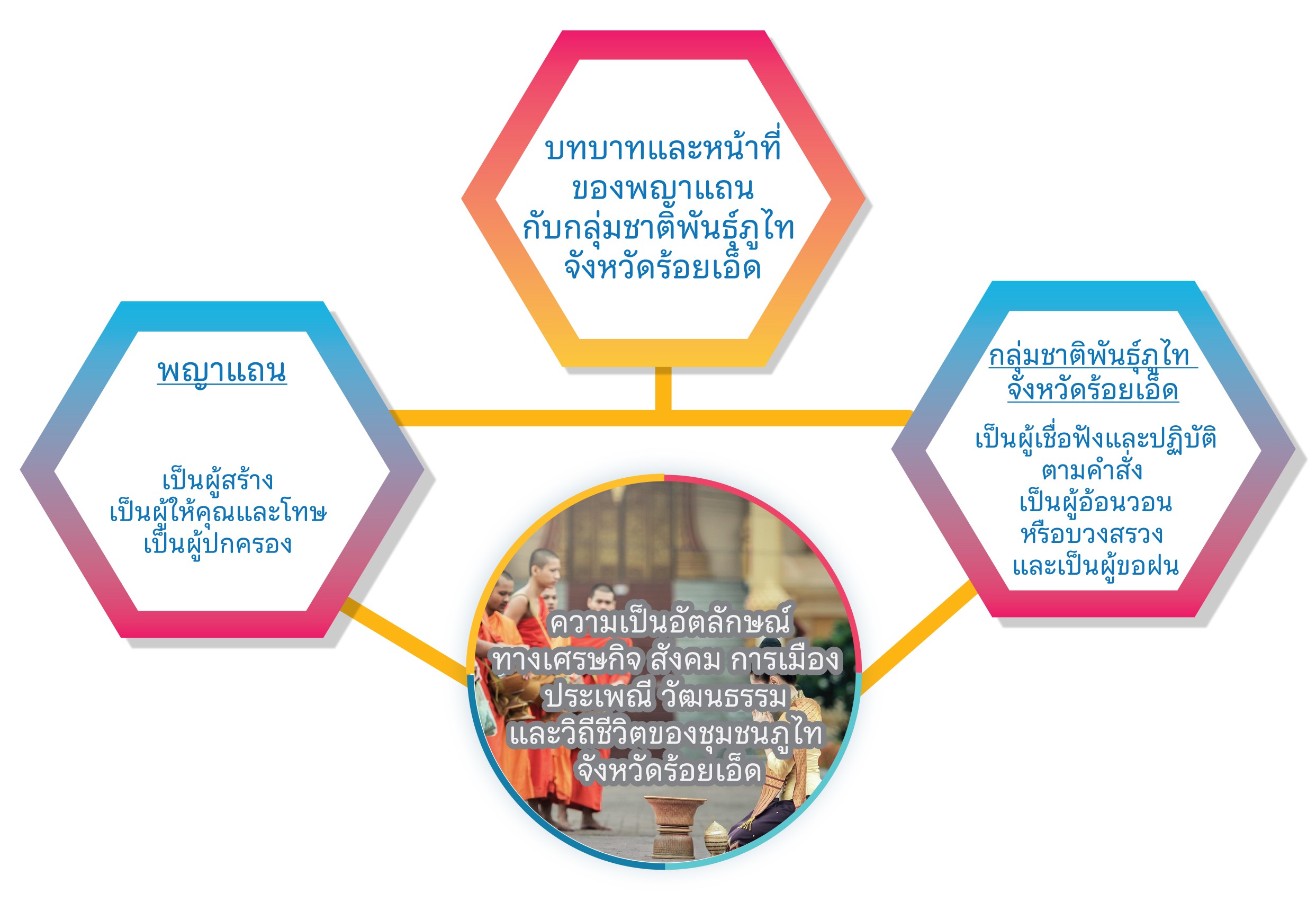The Analysis of the Concept of Phaya Than of Phu Thai Ethnic Group in Roi Et Province
Main Article Content
Abstract
The purposes of this research were: 1) to study the concept of Phaya Than of the Phu Thai ethnic group, 2) to study the concept of Phaya Than of the Phu Thai ethnic group, and 3) to analyze the Concept of Phaya Than of the Phu Thai ethnic group. This qualitative research gathers information from documents, related studies, in-depth interviews, Behavioral observations, and focus group discussions. Descriptive data analyzed according to inductive principles.
The results revealed that:
1. The concept of Phaya Than of the Phu Thai ethnic group is a concept that shows the role of Phaya Than in the Phu Thai ethnic group in 3 ways as follows: 1) the creator of all things, 2) giving benefits and punishment, and 3) the ruler, while the Phu Thai ethnic group has a role. There are 3 aspects of Phaya Than as follows: 1) obey and follow orders 2) Plead and 3) ask for rain.
2. The concept of Phaya Than of the Phu Thai ethnic group. It is a concept that shows the role of Phaya Than in the Phu Thai ethnic group in 3 ways as follows: 1) the creator of all things, 2) giving you and harm, and 3) the ruler, while the Phu Thai ethnic group. There are 3 roles for Phaya Than as follows: 1) obey and Follow orders 2) beg and 3) ask for rain.
3. This concept of Phaya Than influences the Phu Thai ethnic group in 5 areas as follows: 1) Local economy Affects behavior in producing products for use in the community and distributing income to the community thoroughly. 2) Local society Affects expression behavior In terms of cooperation in participating Various activities in the community 3) Local politics Affects expression behavior In terms of participation in thinking about solving community problems 4) Local traditions and culture Affects expression behavior In terms of creating the Bun Bang Fai tradition Including promoting and preserving the Bun Bang Fai tradition and 5) local way of life, resulting into expressive behavior In terms of living a simple life according to the Phu Thai way and being open to a modern way of life that is consistent with the traditional Phu Tai way of life.
Article Details

This work is licensed under a Creative Commons Attribution-NonCommercial-NoDerivatives 4.0 International License.
เพื่อให้เป็นไปตามกฎหมายลิขสิทธิ์ ผู้นิพนธ์ทุกท่านต้องลงลายมือชื่อในแบบฟอร์มใบมอบลิขสิทธิ์บทความ ให้แก่วารสารฯ พร้อมกับบทความต้นฉบับที่ได้แก้ไขครั้งสุดท้าย นอกจากนี้ ผู้นิพนธ์ทุกท่านต้องยืนยันว่าบทความ ต้นฉบับที่ส่งมาตีพิมพ์นั้น ได้ส่งมาตีพิมพ์เฉพาะในวารสาร วิชาการธรรม ทรรศน์ เพียงแห่งเดียวเท่านั้น หากมีการใช้ ภาพหรือตารางของผู้นิพนธ์อื่นที่ปรากฏในสิ่งตีพิมพ์อื่นมาแล้ว ผู้นิพนธ์ต้องขออนุญาตเจ้าของลิขสิทธิ์ก่อน พร้อมทั้ง แสดงหนังสือที่ได้รับการยินยอมต่อบรรณาธิการ ก่อนที่บทความจะได้รับการตีพิมพ์References
จีราภรณ์ จันโสม. (2562). แนวคิดผีฟ้าในเชิงปรัชญาของชุมชนบ้านนาเสียว ตำบลนาเสียว อำเภอเมือง จังหวัดชัยภูมิ. พระนครศรีอยุธยา: มหาวิทยาลัยมหาจุฬาลงกรณราชวิทยาลัย.
ประยงค์ แสนบุราณ. (2556). ความเชื่อเรื่องพระยาแถนของกลุ่มชาติพันธุ์ในสังคมกลุ่มวัฒนธรรมพื้นบ้านภาคอีสาน. วารสารมนุษยศาสตร์สังคมศาสตร์ มหาวิทยาลัยขอนแก่น, 29(3), 21-40. https://so01.tci-thaijo.org/index.php/HUSO/article/view/6102
พระคงศักดิ์ สิริคุตโต (หมั่นวิชา). (2559). ศึกษาความเชื่อและพิธีกรรมที่มีต่อประเพณีบุญบั้งไฟของชุมชนบ้านธาตุ ตำบลบ้านธาตุ อำเภอเพ็ญ จังหวัดอุดรธานี. พระนครศรีอยุธยา: มหาวิทยาลัยมหาจุฬาลงกรณราชวิทยาลัย.
พระมหาใจสิงห์ สิริธมฺโม (เถื่อนศรี), จรัส ลีกา, สุวิน ทองปั้น, พระมหาสากล สุภรเมธี และพระมหาณัฐพันธ์ สุทสฺสนวิภาณี. (2563). การพิสูจน์ความมีอยู่ของพญาแถนในสังคมล้านช้าง. วารสารบัณฑิตศึกษามหาจุฬาขอนแก่น, 7(1), 197-211. https://so02.tci-thaijo.org/index.php/jg-mcukk/article/view/240464/164076
มหาบุญมี เทบสีเมือง. (2545). หินดาวเล่านิทานพญาแถน. กรุงเทพฯ: สุขภาพใจ.
_______. (2556). ความเป็นมาของชนชาติลาว เล่ม 1. (พิมพ์ครั้งที่ 3). กรุงเทพฯ: สุขภาพใจ.
_______. (2556). ความเป็นมาของชนชาติลาว เล่ม 2. (พิมพ์ครั้งที่ 2). กรุงเทพฯ: สุขภาพใจ.
สุเทพ ไชยขันธ์. (2556). ความเป็นมาของคนอีสาน ภาคพิเศษ ผู้ไท ลูกแถน สายสัมพันธ์เชื่อมพรมแดนอาเซียนเป็นสิ่งเดียวกัน. กรุงเทพฯ: สุขภาพใจ.
_______. (2557). ความเป็นมาของคนอีสาน ภาค 2: ผู้ไท ลูกแถน. กรุงเทพฯ: สุขภาพใจ.
_______. (2557). นิทานพญาแถน แก่นตำนานอาเซียน. กรุงเทพฯ: สุขภาพใจ.
